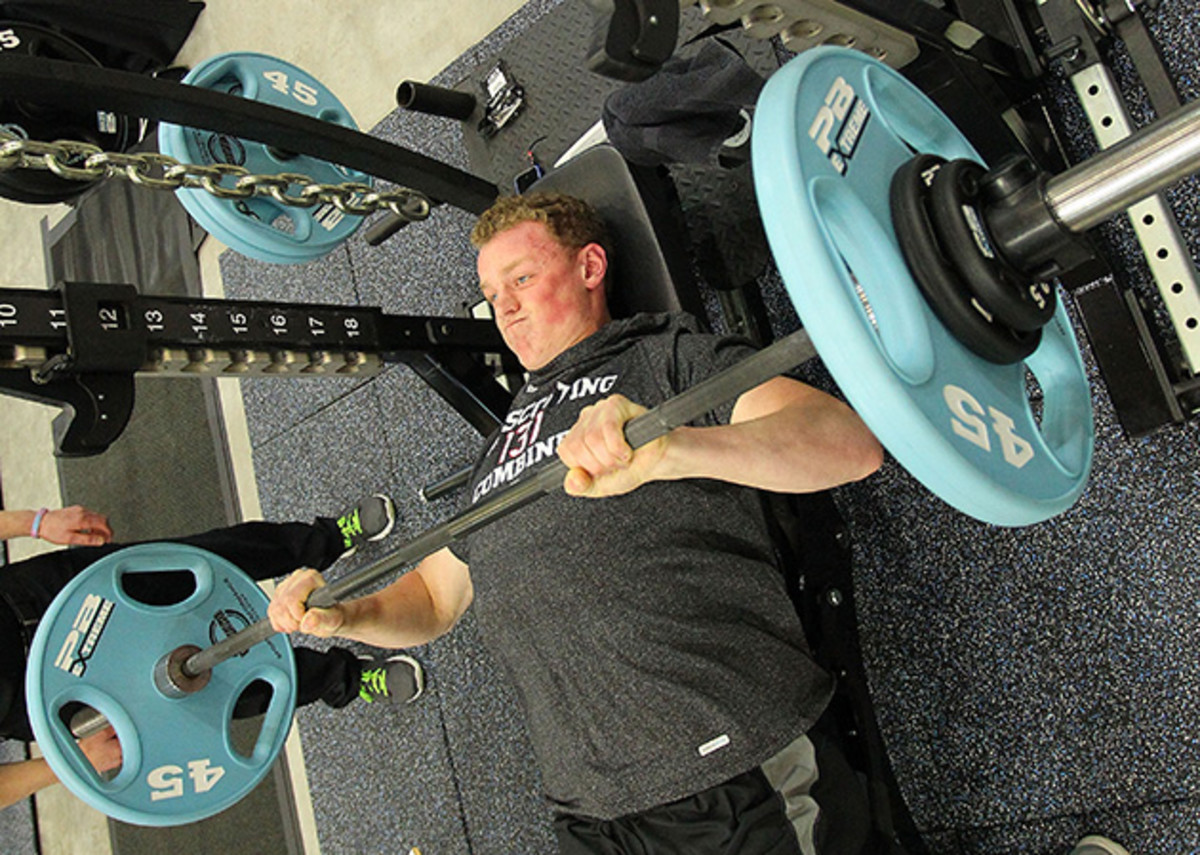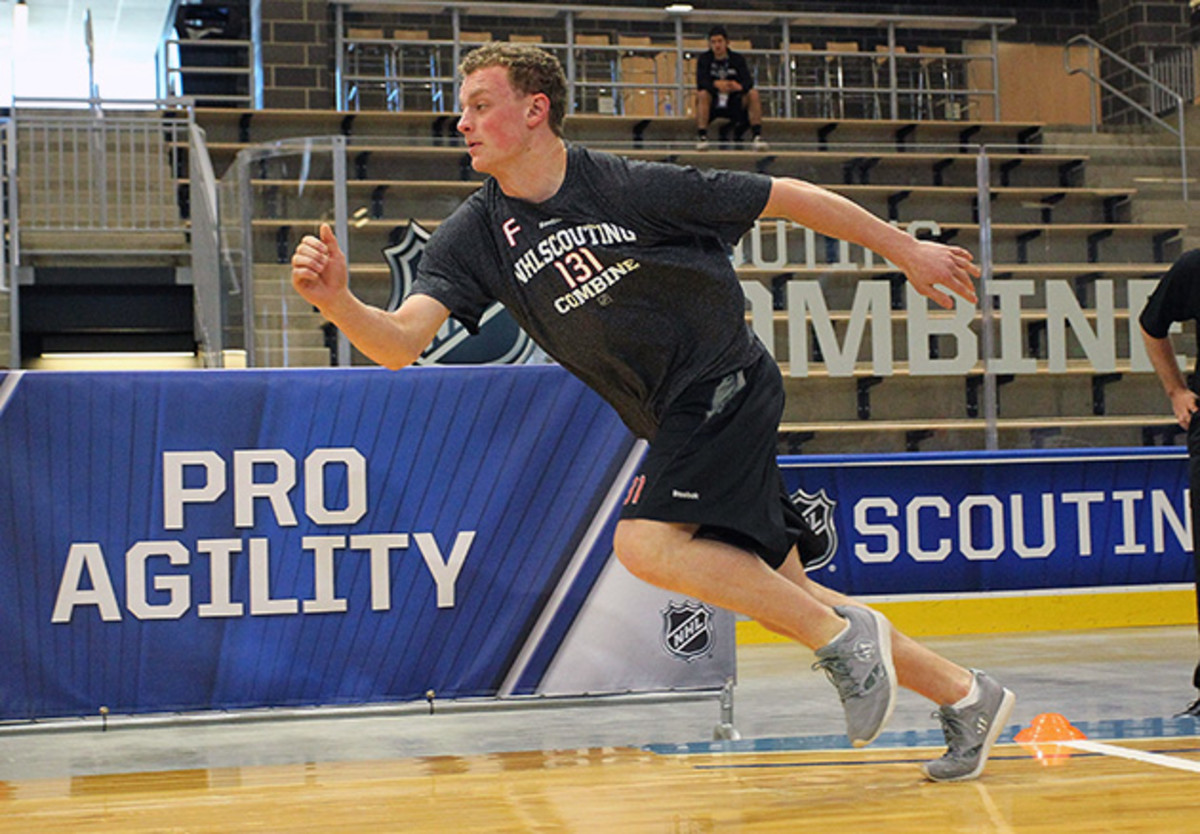How top NHL draft prospect Jack Eichel is building a pro-ready body

On the ice, Jack Eichel’s vision is a gift. His transcendent hockey skills are a combination of natural talent and repetition. His body, however, is the result of good genes, and good old-fashioned sweat equity.
Countless hours in the weight room have layered muscle on Eichel's 6'1", 195-pound frame, allowing him to withstand the rigors of the game. The 18-year-old center from Boston University led the nation in scoring (26 goals, 45 assists, for 71 points), and was an astounding plus-51 on the season. In May, he became the first draft-eligible player in more than two decades—the last being former Buffalo Sabre great Phil Housley—to play for the United States in the IIHF World Championships (where he collected two goals, including an overtime game-winner, and seven points).
Eichel, college hockey’s Hobey Baker winner, is generally considered a lock for the second overall pick, behind Canada’s Connor McDavid, in tonight’s NHL entry draft. But his body of work began years ago.
“When I was younger, I was fascinated with becoming an explosive skater,” says Eichel, a Massachusetts native. “I wanted to be faster than everyone else on the ice. I think that’s one of the most important things in the game.
“I figured there was no better way to get faster than just get stronger in the weight room. I definitely take my off-ice workouts and my time in the weight room very seriously. I think of it as an opportunity to become a lot better. It really translates to the ice, in terms of flexibility, strength, coordination, agility and conditioning. I think it all goes in to how you perform.”
Eichel has a sturdy build, first developed with trainer Ben Bruno (now based in Los Angeles) and further refined at BU with strength and conditioning coach Anthony Morando. That frame, with thick legs and mid-section, enables the teenager to play his skill game while fending off larger opponents.
Speed zone: Saints WR Brandin Cooks training to get even faster this season
“I looked at the weight room as a place where I could become a much better hockey player, and I thought it was a great opportunity to be stronger on pucks,” says Eichel. “You look at guys like Sidney Crosby and [Evgeni] Malkin and [Ryan] Getzlaf, and some of the better players in the NHL. [Joanthan] Toews, [Patrick] Kane.
“Those guys are so strong on the puck. You see people try to knock them off the puck, and it doesn’t work. It has a lot to do with their core strength. Obviously, they’re extremely gifted players, but I don’t think any of them would be the player they are if they didn’t put the time in the weight room.”
According to Morando, the goal of the BU strength staff was to keep Eichel and his teammates injury-free over the course of a six-month collegiate season.
"When Jack came to me, he obviously had a base of strength. There’s a base of explosiveness,” Morando says. “That’s where he happens to be very, very good. So what do we have to do next? We have to keep Jack healthy.”
That’s easier said than done, says Morando, because of the both the physical nature of the game, and the unique stance the sport requires.

“We need to make sure that their quads are strong. We need to make sure their glutes and their hamstrings are strong,” he says. “And we need to make sure that they can pull, because they’re constantly rotated internally through their joints, on the ice, because they’re hunched over, and they have this funky look to them.”
Dedication to the BU weight room helped the Terriers reach the NCAA championships game (where they lost to Hockey East rivals, Providence, 4-3). Not only did weight work create a strong sense of camaraderie, says Eichel, but it also allowed Morando to monitor the players, and address any concerns regarding muscle imbalance that could leave them susceptible to injury or prevent them from reaching their physical peaks.
Training with Frank Kaminsky: The big man steps it up for the NBA draft
“It’s all about having constant attention to detail and assessment,” says Morando.
Next year is still an open question for Eichel. As of late May, he still hadn’t made any decisions about whether he’ll leave school, regardless of where he is picked in the draft and what team makes that selection. But there’s little doubt that he has the talent to make the jump.
“The sky’s the limit for Jack, because of his work ethic,” said BU coach Dave Quinn during last season. “He's so coachable, and he’s just so driven. When you put him in one-on-one situations, I don't know if I’ve been around as skilled a player who is as competitive as he is.
“He’s got a lot of edge to his game, he’s got a lot of ‘oomph’ to his game. He needs to be more consistent, but it’s there, and I think when continues to grow and mature as a player it’s going to be a big part of his game.”
If Eichel leaves for the NHL next year, consistency and injury prevention become even more important, since he’ll face a schedule twice as long as this past season's. And expectations will be high.
“The team that gets Jack is going to be a needy team,” said Dan Bylsma of the Buffalo Sabres, who own the second pick in the draft, last December. “It’s going to be a team that is going to be near the bottom of the league. That’s certainly going to be a situation where they’re going to need an elite centerman.

“I do think he can play, but, for the development of the player, is it the best thing to go right in and play? It's a tough question. There are bumps in playing in the National Hockey League. It’s going to be difficult.”
To battle those bumps, Eichel has three favorite exercises. All are considered full-body workouts, employing multiple large muscle groups: the power clean, the trap bar deadlift (also known as a hex bar deadlift), and the single-leg squat. Morando suggests adding a dumbbell pull to provide upper body balance to counteract hockey’s hunched posture.
The power clean, said Eichel, cultivates speed and power by targeting the quadriceps and core strength, plus the major lower-body joints (hips, knees, and ankles). “That’s the exercise I focus the most on in terms of wanting to add more weight, and doing it more frequently, and I’ve been doing it for a long time,” he says. “That’s something that has really helped me become more explosive.”
How I learned to kill in five moves—and got a killer workout to boot
The trap bar deadlift uses a number of muscle groups, including legs and core, to enhance stability and acceleration. “If a player’s glutes and hamstrings are strong, they’re going to have more push on the ice,” says Morando. The trap bar itself, by providing a neutral grip from the side, allows the athlete to maintain better posture, as opposed to reaching forward, helping to avoid injury.
The single-leg squat accentuates that hockey, while played on two feet (or skates), is defined by a skating stride that takes place one leg at a time. “Hockey is a quad-dominant sport,” says Morando. “The quads are going to need to be strong and forceful.” Plus, studies have shown that athletes can tax a single leg with more than half the weight of a two-legged squat, making this approach more efficient.
Finally, dumbbell pulls spotlight the arms, shoulders, back, latissimus dorsi (or “lats”), and core muscles. Morando says that individual pulls are preferred for the same reason that single-leg squats are so effective, because they work reciprocal motions in a safer, more efficient manner. “It’s asymmetrical. You’re pulling with one limb at a time,” he says. “You can get a really great, testosterone-heavy response with the dumbbell.”
Hockey training: A sample of Jack Eichel's regimen
Exercises provided by BU strength and conditioning coach Anthony Morando
Power Clean: With feet underneath the hips, and hands gripping the barbell slightly wider than shoulder width, lift the bar quickly, extending the hips, and shrugging slightly to get under the bar while landing in a partial squat. Bring the bar to the chest, pushing the elbows forward. Finish by standing with the bar. Reset.
Trap Bar Deadlift:With feet directly underneath the hips, and toes pointing forward (to ensure proper knee tracking), squeeze shoulder blades together and, while keeping the head and chest up to ensure a neutral spine position, bend much like a squat to grab the trap bar with a centered grip, aligning hands with feet for a balanced stance. Push through the floor, lifting the trap bar with the hips and shoulders rising together at the same time. Shoulders, hips, knees and feet should all be properly "stacked."
Single Leg Squat:From a standing position, stride forward with one foot, keeping the knee directly above the foot, while lowering the trailing knee to the floor. Keep head and chest up, to keep the spine neutral and concentrate on the core and quadriceps muscles. Graduate from unweighted squats to incorporating dumbbells to increase resistance. Elevating the rear foot will isolate the supporting quad and simultaneously challenge balance proprioceptors.
